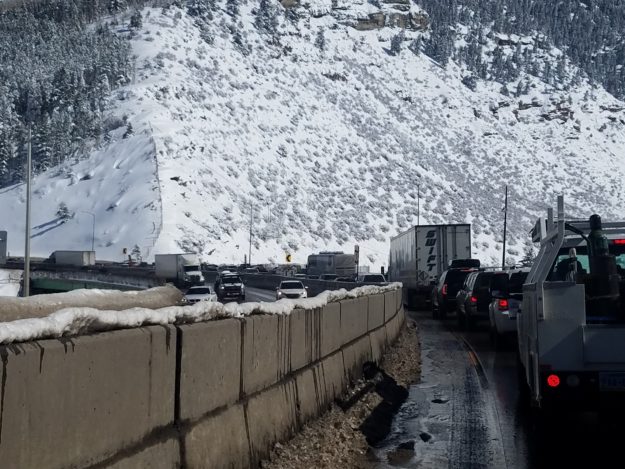Widgetized Section
Go to Admin » Appearance » Widgets » and move Gabfire Widget: Social into that MastheadOverlay zone
Colorado population booms as road funding stagnates, climate warms

More than halfway through the current session, Colorado lawmakers have been going big – tackling everything from all-day, free kindergarten to more local control over oil and gas drilling to taking away your guns if you’re a proven threat to yourself or others. But so far relative crickets on fixing something those of us living in the Vail Valley are impacted by every waking day: the snarled, outdated, mangled mess that is Interstate 70.
In fact, there hasn’t been a lot coming out of the legislature dealing with Colorado’s crumbling road infrastructure in general. We have a first-world economy and third-world roads in a state with some of the most variable temperatures in the lower 48. Climate change is making that weather even more variable and forcing transportation officials and scientists to deal with radical new scenarios on an annual basis – like the recent round of historical avalanches along I-70.

Aside from a long-overdue traction law proposal spearheaded by our local Democratic state lawmakers Dylan Roberts of Avon and Kerry Donovan of Vail – a proposal held up, ironically, in past sessions by former CDOT employee and state Sen. Randy Baumgardner – there hasn’t been much talk of big-picture solutions to continue unwinding the I-70 stranglehold to Vail. But that Band-Aid, traction-law fix to keeping I-70 flowing may actually pass this session.
I wrote extensively about both topics – crumbling transportation infrastructure and the impacts of climate change — recently for Colorado Politics and its parent publication, the Colorado Springs Gazette. And the Denver Post just came out with a look at four possible legislative paths toward more transportation funding before the General Assembly concludes its work in early May.
Here’s an excerpt from a version of my story on climate change, snowpack and roads that ran on the front page of the Colorado Springs Gazette on Sunday:
Snow scientists, avalanche experts grappled with Colorado’s warming climate
VAIL, Colo. – As snow scientists and highway officials literally and figuratively dig out from under a mountain of snow left by Wednesday’s “bomb cyclone” and a recent five-foot-plus heavy, wet, avalanche-triggering snow cycle in the mountains, they’re collectively trying to grapple with what comes next and how it all connects to climate change in Colorado.
For the Colorado Department of Transportation, which has been dealing with historical avalanches along the I-70 corridor into the mountains – along with stranded motorists scattered across the Eastern Plains by the bomb cyclone – that means coming up for air over the next week of forecast milder weather and getting a handle on road repairs, melting and rock slides.
“It’s also really just about trying to get our folks rested,” said CDOT’s Tracy Trulove, who’s based in Glenwood Springs. “We’re taking this break in the weather to try to repair some of the road damage. This kind of winter is really tough on us for potholes and sections of the roadway that get damaged. And our team will be taking advantage of this drier week to be sure we are well-stocked with what we need if we’re going into another cycle like this.”
Longer-term forecasts are calling for the return of this season’s consistent snowstorms later this month, and avalanche experts and road crews are bracing for the worst. Part of the problem this season was above-average snowfall building up on steep mountain slopes without sliding. Then a very moist, Pacific storm cycle fell on top of it, triggering huge avalanches down to I-70.
“It’s tough to connect one heavy, wet, Pacific storm cycle to climate change, said Brian Lazar, deputy director of the Colorado Avalanche Information Center, and he added such storms are not all that unusual in Colorado and climate change is playing a role.
“We often talk about things in terms of snow-water equivalent, and so we’re seeing these storms that are dropping three to five inches of water in a 24-hour-period and that’s a significant and rapid load to the snowpack,” Lazar said, referring to the mountain storms earlier this month that triggered huge avalanches along I-70 in Summit and Eagle counties.
“Maybe the number of them this year and just how wet and kind of juicy they’ve been is a little bit out of the normal,” Lazar added. “That’s not inconsistent with predictions of a warmer climate. That warm air can kind of just hold more moisture. Colorado is typically colder and drier, but if the air over Colorado were to get warmer, it can produce wetter storms.”
And here’s an excerpt from a version of my story on what ails I-70 on the cover of Colorado Politics this week:
Colorado ski, tourism industry squeezed by I-70 gridlock, lack of funding
BEAVER CREEK, Colo. – In December, the most decorated ski racer in American history sat in a conference room at a posh slope-side hotel here in the heart of the Vail Valley, smiled slightly, and then threw some serious shade at Colorado’s ski industry, specifically its reliance on the woefully outdated stretch of east-west interstate known as I-70.
Seven-time Olympic and world champion gold medalist Ted Ligety, who grew up in Park City, Utah, had just been asked to assess the chances of both Denver and Salt Lake as the two cities vied for the right to bid on the 2030 Winter Olympics.
“Salt Lake is the no-brainer choice really …,” Ligety grinned. “Denver offers a big challenge having Vail Pass and all that stuff. It’s hard to get up here on a snow day, where I’ve never in my life had Parleys Summit be closed to get to Park City.” Parleys is the high point on I-80 along the ridiculously easy 30-minute drive from Salt Lake City International Airport to Park City.
To be clear, Ligety loves Beaver Creek. He’s won on its famed Birds of Prey World Cup course six times, including a world championship in 2015, but he knows all too well that it can be a shear, unmitigated nightmare to get here from Denver International Airport in the winter. The typically 90-minute, 110-mile drive can turn into two, three, four-plus hours of agony.
The tales of woe are legion on Interstate 70: The Denver day skiers who spent a day on the slopes and then all night driving the 100 miles home. The Vail mayor who flew from France to Denver in only slightly more time than it took to drive from DIA to Vail. The Montana State University admissions official who said so many Colorado kids are flocking to Bozeman because it’s much closer to actual skiing than the University of Colorado at Boulder, aka “Ski U”.
Ligety proved prescient back in December, because a little later that month the United States Olympic Committee cited the “proximity” of Utah’s ski venues to Salt Lake City in choosing the 2002 host over Denver for that possible 2030 bid. It only seems like the last time I-70 was improved was when Denver was awarded the 1976 Winter Olympics back in the early 70s, but actually I-70 wasn’t finished in Glenwood Canyon until 1992 and was by then already obsolete.
Former Gov. Dick Lamm, who helped hand those ’76 Olympics back to the IOC, as recently as 2014 said maybe a future Olympic bid could fix the “I-70 bottleneck,” but now he’s part of the Let Denver Vote campaign on either the June or November ballot to give voters the final say on whether public money should ever be spent on a future Denver Olympic bid. Given our I-70 problem, one wonders why they’re even bothering.
“Ensuring that any future Games don’t spend tax-payer dollars without prior voter approval,” answered Let Denver Vote spokesman Owen Perkins. “You might be right that there’s an aversion to Denver for a variety of reasons, but Denver always seems to be on the table when considering U.S. host cities for Winter Games.”
Fine, some may say, we don’t want the Olympics anyway, but what about the future of the state’s booming $62-billion-a-year outdoor recreation industry – approximately $5 billion of which comes from skiing? Or the 80,000 or so people who moved to the state last year, presumably thinking they’d be just a hop, skip and jump to a pristine high-country meadow?
Colorado may have wrestled away the Outdoor Retailer Show from Salt Lake City because of its more progressive public-lands policies, but what good are those lands if you can’t get to them on the car-choked four-lane interstate out of Denver that climbs over two 10,000-plus-foot passes?
With I-70 congestion currently costing an estimated $1 billion a year, the time to answer some of those questions may have been in the early 1990s – about the same time Utah was bidding on its first Olympics and Colorado voters were approving TABOR – the Taxpayer Bill of Rights that curtails infrastructure spending while keeping governments fiscally restrained.
Colorado’s population has increased 53 percent since 1990 but the lane miles on the state’s highway system have only increased by 2 percent due to budget constraints, Colorado Department of Transportation (CDOT) officials said. About 70 percent of CDOT’s annual $1.4 billion transportation budget goes to maintenance, and Colorado’s 22-cent gas tax – the 12th lowest in the nation – has not been increased since 1991.
Utah, with 2.4 million fewer residents, has an only slightly lower transportation budget and collects nearly 30 cents a gallon in gas taxes while also dipping into state sales taxes revenues to fund transportation.
To the frustration of many, Colorado voters in November voted down a sales tax increase (Proposition 110) that would have funded a $6 billion bond issue for CDOT’s estimated $9 billion budget shortfall over the next decade, and voters also rejected a measure (Proposition 109) that would have authorized a $3.5 billion bond sale.


